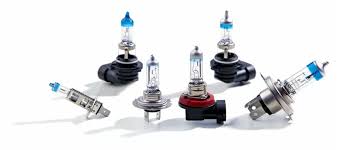
Types of car lamps
Content
Automotive lighting equipment is a set of devices that are mounted inside and around the perimeter of the car, and provide illumination of the road surface in the dark, indicate the dimensions of the car, and also warn of the maneuvers of other road users. The first car light bulbs ran on kerosene, then Edison's revolutionary incandescent bulbs appeared, and modern light sources have gone even further. We will talk about the types of car lamps later in this article.
Automotive Lamp Standards
Automotive lamps differ not only in type, but also in the base. The familiar threaded base was proposed by Edison in 1880, and since then many options have appeared. There are three main plinth standards found in the CIS:
- Domestic GOST 17100-79 / GOST 2023.1-88.
- European IEC-EN 60061-1.
- American ANSI.
The European standard is more common and has its own symbols that determine the type of lamp and base. Among them:
- T - refers to a mini lamp (T4W).
- W (at the beginning of the designation) - baseless (W3W).
- W (at the end after the number) - shows the power in watts (W5W).
- H - designation for halogen lamps (H1, H6W, H4).
- C - soffit.
- Y - orange lamp bulb (PY25W).
- R - flask 19 mm (R10W).
- P - bulb 26,5 mm (P18W).
The domestic standard has the following designations:
- A - car lamp.
- MN - miniature.
- C - soffit.
- KG - quartz halogen.
In the designation of domestic lamps, there are numbers that indicate various parameters.
For example, AKG 12-24 + 40. The first number after the letters shows the voltage, after the dash - the power in watts, and the "plus" indicates two incandescent bodies, that is, low and high beam with power designation. Knowing these designations, you can easily determine the type of device and its parameters.
Types of auto lamp bases
The type of connection with the cartridge is usually indicated on the body. There are the following types of plinths used on cars.
Soffit (S)
Soffit bulbs are mainly used to illuminate the interior, license plates, trunk or glove box. They are located between spring-loaded contacts, which makes them look like fuses. Marked with the letter S.
Flanged (P)
Caps of this type are designated with the letter P and are mainly used in high and low beam headlamps, where a clear position of the spiral relative to the body is required. Also, such lamps are called focusing lamps.
Baseless (W)
Lamps of this type are designated by the letter W. Wire loops are formed on the tides of the bulb and are attached due to the elasticity of the contacts that encircle these loops. These bulbs can be removed and mounted without turning. Typically, this is a miniature standard (T). They are widely used in cars and garlands.
Pin (B)
Pin-base lamps are the most widely used in automobiles. Such a connection is also called bayonet, when the base is fixed in the chuck through a turn.
A symmetrical pin connection with the designation BA and an asymmetrical pin connection (BAZ, BAY) are also divided. A small letter in the marking indicates the number of contacts: p (5), q (4), t (3), d (2), s (1).
The following table shows the location of the auto lamps, their type and marking on the base.
| Where to install the lamp in the car | Lamp Type | Base type |
| Head light (high / low) and fog lights | R2 | P45t |
| H1 | P14,5s | |
| H3 | PK22s | |
| H4 | P43t | |
| H7 | PX26d | |
| H8 | PGJ19-1 | |
| H9 | PGJ19-5 | |
| H11 | PGJ19-2 | |
| H16 | PGJ19-3 | |
| H27W / 1 | PG13 | |
| H27W / 2 | PGJ13 | |
| HB3 | P20d | |
| HB4 | P22d | |
| HB5 | PX29t | |
| Brake lights, direction indicators (rear / front / side), rear lights | PY21W | BAU15s / 19 |
| P21 / 5W | BAY15d | |
| P21W | BA15s | |
| W5W (side) | ||
| WY5W (side) | ||
| R5W, R10W | ||
| Parking lights and room lighting | T4W | BA9s / 14 |
| H6W | PX26d | |
| C5W | SV8,5 / 8 | |
| Interior lighting and trunk lighting | 10w | SV8,5 T11x37 |
| R5W | BA15s / 19 | |
| C10W |
Varieties of car bulbs by type of lighting
Apart from the difference in the type of connection, automotive lighting products differ in the type of lighting.
Conventional incandescent bulbs
Such bulbs are widely used in everyday life. A tungsten or carbon filament is used as a filament. To prevent tungsten from oxidizing, air is evacuated from the flask. When power is supplied, the filament heats up to 2000K and provides a glow.
Burnt out tungsten can settle on the walls of the flask, reducing transparency. Often, the thread simply burns out. The efficiency of such products is at the level of 6-8%. Also, due to the length of the filament, the light is scattered and does not give the desired focus. Due to these and other disadvantages, conventional incandescent lamps are no longer used as the main light source in automobiles.
Halogen
A halogen lamp also works on the incandescent principle, only the bulb contains halogen vapors (buffer gas) - iodine or bromine. This raises the temperature of the coil to 3000K and also extends the service life from 2000 to 4000 hours. The light output is between 15 and 22 lm / W.
Tungsten atoms released during operation react with residual oxygen and buffer gases, which eliminates the appearance of a deposit on the flask. The cylindrical shape of the bulb and the short spiral provide excellent focusing, therefore such products are most often used for headlights in cars.
Xenon (gas discharge)
This is a modern type of lighting fixture. The light source is an electric arc formed between two tungsten electrodes, which are located in a bulb filled with xenon. To increase light output, xenon is pressurized up to 30 atmospheres. The color temperature of the radiation reaches 6200-8000K, therefore special conditions of operation and maintenance are required for such lamps. The spectrum is closer to daylight, but there are also mercury-xenon lights that give a bluish tint. The light beam is out of focus. For this, special reflectors are used that focus the light in the desired direction.
Such devices give an excellent glow, but there are also drawbacks to their use. First of all, the car must be equipped with an automatic beam tilt adjustment system and headlight washers to prevent dazzling of oncoming vehicles. An ignition block is also required to provide voltage for the arc to occur.
LED Light
LED elements are gaining more and more popularity now. Initially, LED lamps were used mainly for brake lights, rear lamps, etc. In the future, automakers can completely switch to LED lighting products.
The glow in such lamps is formed as a result of the release of photons from semiconductors when electricity is applied. The spectrum can be different depending on the chemical composition. The power of automotive LED lamps can reach 70-100 lm / W, which is several times higher than that of halogen lamps.
The advantages of LED technology include:
- vibration and shock resistance;
- high efficiency;
- low power consumption;
- high light temperature;
- environmental friendliness.
Is it possible to install xenon and LED lamps in the headlights
Self-installation of xenon or LED lamps can lead to problems with the law, since their power is several times higher than halogen ones. There are three main options for using LED auto lamps:
- The use of LEDs for the head low and high beam was originally envisaged by the automaker, that is, the car was purchased in this configuration.
- You can install LEDs or xenon on your own if it is provided for in more expensive trim levels of the car model. In this case, you will have to completely change the headlights.
- Installation of LEDs in standard halogen headlights of a car.
The latter method is not entirely legal, since the spectrum and intensity of illumination changes.
Pay attention to the labeling. If HR / HC is specified, this corresponds to the use of halogen lamps. For xenon, the corresponding index is D and LED for diodes. The power of the light source should not differ from that declared by the manufacturer.
There are also specific requirements of the Customs Union Technical Regulations for LED and xenon equipment. There must be a system for automatic adjustment of the light beam by angle, as well as a cleaning device. In case of violation, a fine of 500 rubles is provided. In some cases, up to deprivation of rights from six months to one year.
When choosing and replacing car lamps, you should pay attention to the marking in order to select the appropriate type. It is worth choosing those bulbs that are recommended by the manufacturer.
